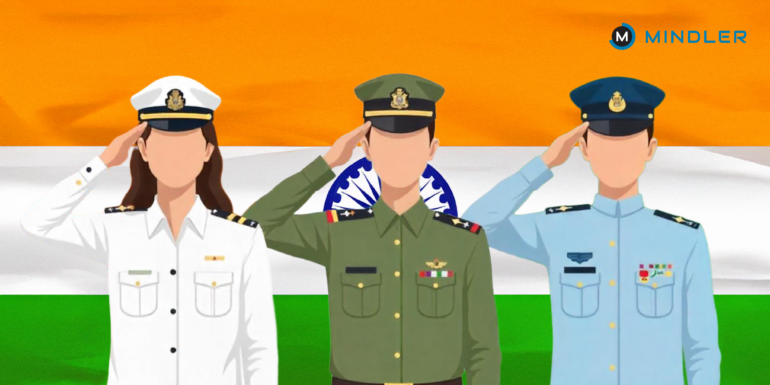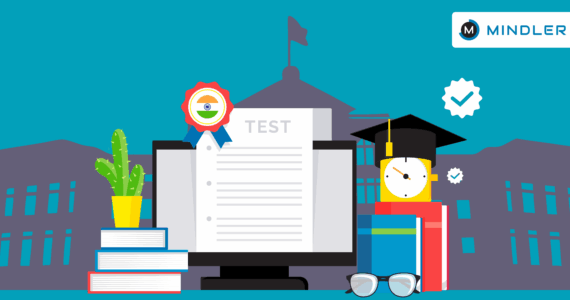Every year, thousands of young people join the Indian armed forces, exploring career opportunities after the 12th grade. On average, the Army recruits 60,000 people each year, while the Navy recruits 5,332 and the Air Force 5,723. These jobs offer good pay, housing, medical care, and opportunities for promotion based on both length of service and individual performance.
Entry into the forces depends on educational background. Science students generally enter technical or engineering roles, commerce students take up logistics or administrative positions, and arts students find work in clerical or support roles. This allows candidates from different fields to build careers that match their skills and interests.
Why Choose Career Opportunities in the Armed Forces in India?
Career opportunities in the armed forces provide several benefits related to living and career growth. These include:
- Structured Career Growth: Career advancement in the armed forces is systematic, with promotion opportunities based on performance and service. You advance gradually with more responsibility and a higher salary.
- Leadership and Team Skills: Army officer jobs begin with leadership training, and then give you the opportunity to apply your skills in the real world, working with people and resources. Such competencies are useful in most careers in both the public and private sectors.
- Financial Stability and Job Security: Armed forces roles offer reliable income, with officers starting salaries from about ₹56,000 per month, while other ranks (like Sepoys) begin with a basic pay of about ₹21,700 per month. Alongside regular pay, personnel receive pensions, allowances, and job protection, meaning their employment is secure and not easily terminated, which helps provide long-term financial stability.
- Early Retirement With Pension: Pension benefits in the Indian armed forces vary according to rank. After 15 to 22 years (usually in their 40s) of service, non-officer personnel normally retire and are entitled to a pension depending on length of service and rank. The retirement age of officers is 54-60 years, with pensions rising according to years of service. This system gives a stable income post-service and contributes to financial stability.
- Comprehensive Healthcare: Free medical care is available for both you and your family through military hospitals. It reduces out-of-pocket healthcare expenses while ensuring quality treatment.
- Housing and Living Benefits: Free or low-cost housing is provided throughout a service member’s career, reducing living expenses and supporting a stable lifestyle.
- Education and Skill Development: The Indian defence forces support education and technical training for personnel across all branches. Sponsored programs include degrees in engineering, management, and defence studies, offered through institutions like the National Defence Academy (NDA), Defence Services Staff College (DSSC), and other recognised universities. These opportunities help personnel upgrade skills and qualifications within limits set by rank and service requirements.
- Second Careers After Retirement: Veterans often take on different jobs in the army or transition to roles in civilian sectors, consulting, or leadership. Their training and discipline are valued across many industries.
Three Main Branches of the Indian Armed Forces
The defence system of India consists of three divisions that have specialised roles, training and careers:
1. Indian Army – Land-Based Operations
The Indian Army is the biggest in size, as well as it provides the most diversified career prospects. Being a land force, there are numerous career options within the military in various specialisations, including:
- Infantry and combat operations
- Artillery and weaponry systems
- Engineering and construction
- Medical and healthcare services
- Intelligence and reconnaissance
- Communication and signals
- Supply and logistics management
2. Indian Navy – Maritime Defense
The Navy has an interest in the security of the Indian coast and maritime interests. Naval careers involve specialisation in ships, submarines, and coastal bases, regarding security, engineering, and operational duties, such as:
- Naval operations and seamanship
- Marine engineering and technology
- Aviation (Naval pilots and crew)
3. Indian Air Force – Aerial Operations
The Air Force is the most technological branch and has job opportunities in aviation and advanced systems for interested individuals, including:
- Radar and communication systems
- Meteorology and weather forecasting
- Ground support and logistics
Popular Entry Routes To A Career In the Armed Forces After 12th
In India, the armed forces have many entry points after the 12th standard:
1. National Defence Academy (NDA)
The NDA is the primary entrance to aspiring officers in the Army, Navy, or Air Force. It offers training and leadership to aspiring officers.
- Eligibility: For the Army wing, students from any stream can apply. Navy and Air Force wings require Physics, Chemistry, and Mathematics (PCM) in the 12th grade.
- Selection Process: The UPSC conducts the NDA exam twice a year, testing Mathematics, General Ability, and English. Candidates who pass are called for the SSB interview, which assesses leadership and physical fitness.
- Training: Selected candidates undergo three years of training at NDA, followed by service academy training before commission.
NDA graduates begin as officers and have the option to seek any of the many army officer jobs or similar positions in the Navy and Air Force..
2. Technical Entry Scheme (TES)
The Technical Entry Scheme (TES) is a path through which students pursuing the science stream can join the Indian Army as technical officers. It is currently restricted to single male applicants and does not involve a written test; it seeks to induct technically proficient personnel into service.
- Eligibility: 12th pass with PCM and a minimum of 60% marks.
- Selection Process: No written test; selection through SSB interview based on academics and aptitude.
- Training: One year of training at IMA or OTA, then specialised technical training.
TES officers work with equipment, weapons, and high-tech systems. This role is one of the many types of jobs in the military that focus on technical knowledge and engineering skills.
3. Navy B.Tech Entry
This path is aimed towards 12th pass PCM students who are interested in being engineers in the Navy. It provides a technical position in the naval forces.
- Eligibility: Minimum 70% marks in PCM and JEE Main rank.
- Selection: Shortlisted candidates face the SSB interview.
- Training: One year at the Indian Naval Academy, followed by technical training.
This prepares candidates for commissioned roles in naval engineering and technical branches within the Indian Navy.
Non-Officer Military Careers After 12th
These routes include technical, administrative, and support roles. While they don’t lead to commissioned officer ranks, they offer vital army jobs and paths to serve in the armed forces with opportunities to advance internally.
1. Soldier Entry (Army)
These roles support the day-to-day functioning of the Army and are categorised into general duty, technical, clerical, and tradesman roles. Recruitment is now conducted under the Agniveer scheme, introduced in 2022.
- Eligibility:
- General Duty: Class 10 pass with at least 45% aggregate
- Technical: 10+2 pass with Physics, Chemistry, Maths, and English
- Clerk/SKT: 10+2 pass with minimum 60% aggregate and 50% in each subject
- Tradesman: Class 8 or 10 pass, depending on trade
- Age: 17.5 to 21 years (varies by trade)
- Trades: General Duty, Clerk, Tradesman
2. Airmen And Sailors
The 12th pass candidates are also recruited by the Air Force airmen and the Navy sailors in both technical and non-technical posts. These are enlisted jobs that are concerned with maintenance, logistics, and operating support in the military.
How to Prepare For A Career In the Armed Forces
To take steps towards an armed forces career, aspirants should:
- Keep viewing official recruitment advertisements by UPSC and defence recruitment boards regularly.
- Prepare for the key defence forces competitive exams, focusing on general knowledge, mathematics, English, and reasoning skills.
- Be physically fit to pass the rigorous physical exams.
- Practice for the Service Selection Board (SSB) interviews that examine personality, leadership, and psychological strength.
- Stay updated on medical standards and documentation requirements.
Conclusion
The Indian Armed Forces offer career opportunities that evolve and expand with technological developments. These roles cover a wide range, including frontline duties, technical positions, and support services. They assist individuals in acquiring skills and leadership experience.
A career in the military offers a secure job, systematic skill advancement, and a chance to serve the nation. It is a viable alternative to 12th pass students seeking long-term career advancement and job fulfillment.








